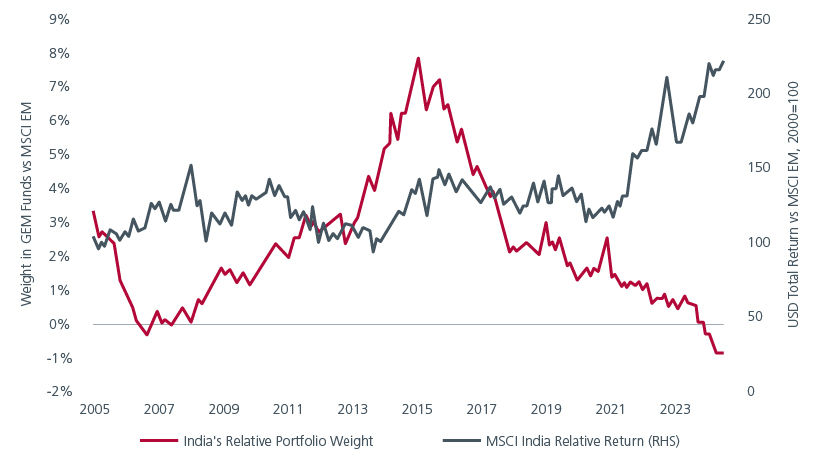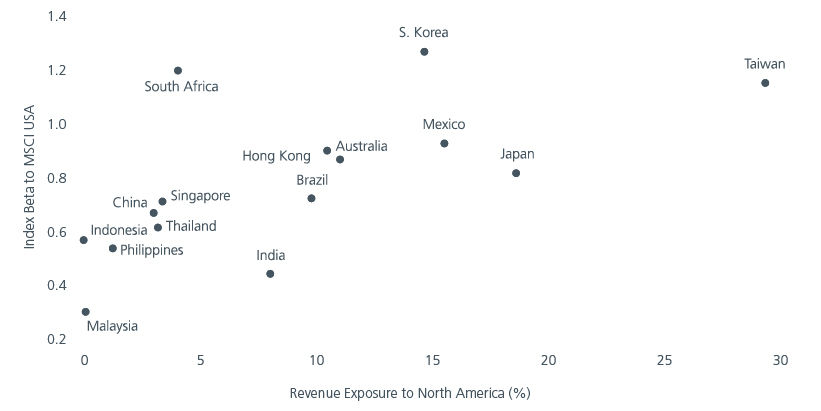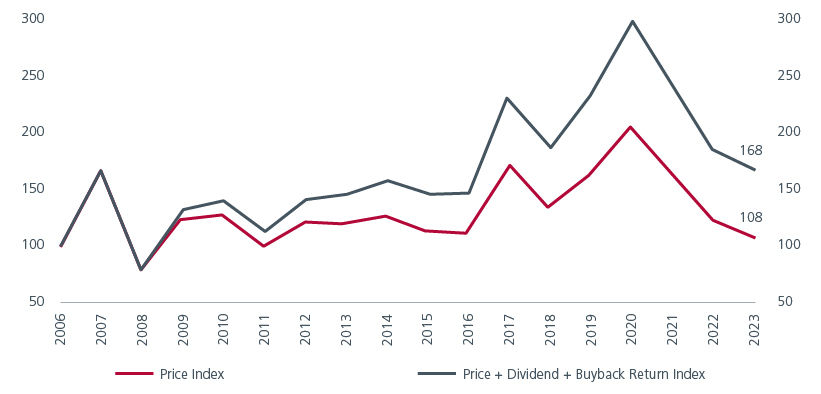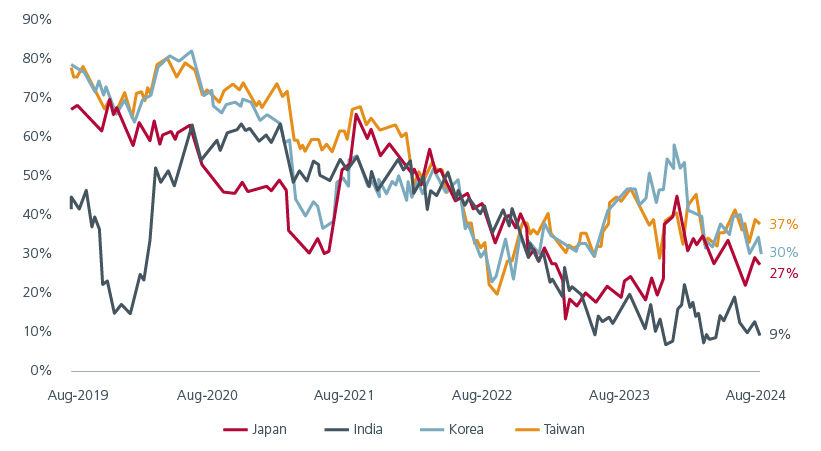Executive Summary
- Idiosyncratic factors helped China and India outperform most Asian markets during the correction in August. We believe that these factors will continue to position these markets favourably during future periods of volatility.
- The resilience of the Indian equity market can be attributed to its strong domestic investor base, low revenue exposure and low market beta to the US. China’s stability is supported by its cheap valuations, low institutional ownership and improving fundamentals in key sectors such as the internet.
- A combined China-India portfolio is not only resilient against global volatility but also offers significant diversification benefits given the declining correlation between the two markets.
Risk assets sold off sharply in early August on the back of a mix of factors, including concerns over the sustainability of AI spending and monetisation, fears of a US recession and the unwinding of the yen carry trade. Fig. 1. China and India were among the few Asian markets that performed better than the rest, underpinned by idiosyncratic factors. We believe that these factors will continue to position these markets favourably during future periods of volatility.
Fig. 1. Performance of selected equity markets on 5th August

Source: Bloomberg. MSCI Indices in USD terms.
India – domestic flows hold sway
India’s relative outperformance during the recent sell-off may come as a surprise given concerns over its expensive valuations. However, unlike other Asian markets which are more dependent on foreign inflows, the Indian equity market is more reliant on domestic flows, which tends to be “stickier”. Although India is often viewed as a popular market among foreign investors, India’s relative portfolio weight in Global Emerging Market (EM) funds is at its lowest since 2005, despite the market’s outperformance. Fig. 2.
Fig. 2. MSCI India’s portfolio weight and total return relative to MSCI EM

Source: EPFR country allocation, FactSet, Morgan Stanley Research. Data as of July 31, 2024. *Fund weight as of June 2024.
MSCI India also has a low beta to the MSCI USA Index, as shown in Fig. 3. India’s lower revenue exposure to North America potentially reduces its vulnerability to US recession risk. India’s Information Technology (IT) services sector, which has the highest exposure to the US, has already experienced slower growth over the last one and half years, driven by vendor consolidation.
Fig. 3. Index beta to MSCI USA vs revenue exposure to North America

Source: Bloomberg, Morgan Stanley Research; Data as of July 26, 2024; Note: Betas are calculated based on MSCI indices unless specified otherwise; weekly returns, rolling 52 weeks.
With the Federal Reserve (Fed) poised to cut rates in the coming months, the strength of the US dollar may moderate as interest rate differentials narrow between the US and the rest of the world. Historically, Emerging Markets tend to outperform when the dollar index weakens. At the same time, Fed rate cuts potentially give the Reserve Bank of India room to bring rates lower (if needed) without stoking volatility in the Indian rupee.
China – marching to its own beat
Like India, we believe that the Chinese equity market will be relatively resilient in the face of global volatility given its trough valuations, low exposures among institutional investors and improving fundamentals in selected key sectors.
At a 12-month forward price-to-earnings ratio of 9x, MSCI China is trading at a trough relative to its own history and the region. The challenges facing the Chinese economy are well known – a weak property market, low consumer confidence and a lack of effective stimulus from the government. A sizeable stimulus package will be needed to lift investor sentiment. Till then, with the government encouraging companies to return more cash to shareholders, dividends and share buybacks should help to stabilise the market. Fig. 4.
Fig. 4. Dividends and buybacks have been an important component of returns for MSCI China

Source: MSCI, FactSet, Goldman Sachs Global Investment Research (as of 24 June 2024).
China is currently one of the most unloved equity markets amongst investors - global investor positioning in Chinese equities is at its lowest in 12 years. This suggests that the market has less room to fall further if overall investor risk aversion rises. Fig. 2. had earlier shown that like MSCI India, MSCI China’s revenue exposure to North America is low compared to the other EMs, which should also make it less vulnerable to US recession risk. On the macro front, the US’ share of China’s total exports has fallen from a high of 20% in 2001 to 14% in the first quarter of 2024. In contrast, ASEAN’s share of China exports has more than doubled from 7% to 17% over the same period.
Importantly, MSCI China’s correlation with other markets such as Japan, Taiwan and Korea has been trending down. Fig. 5. Its correlation with MSCI India is even lower. As such, combining both markets in a portfolio can provide investors with significant diversification benefits.
Fig. 5. Rolling correlation with MSCI China

Source: FactSet, MSCI, Goldman Sachs Global Investment Research (15 Aug 2024).
Exhibiting resilience
Besides the market sell-off in August, we note that the Indian stock market has remained resilient to two unexpected domestic “shocks” this year - Prime Minister Modi’s smaller than expected majority in the June election and the capital gains tax increase in the July India budget.
Given the strength of its domestic inflows, it is unlikely that a US recession would derate the Indian equity market. During periods of market volatility, our value focus should allow us to participate in the India structural growth story while providing investors with some buffer i.e. potentially falling less when the market falls.
With periods of volatility expected in the coming months, MSCI China’s trough valuations, low expectations among investors and low correlations with other equity markets should make the market relatively resilient. Although the performance of the Chinese equity market has been disappointing over the last few years, it is in such conditions that value investors are able to uncover attractive bargains. Notably, the internet sector, which accounts for 39% of the MSCI China Index, has been enjoying positive earnings momentum, as e-commerce competition declines and share buybacks accelerate.
The information and views expressed herein do not constitute an offer or solicitation to deal in shares of any securities or financial instruments and it is not intended for distribution or use by anyone or entity located in any jurisdiction where such distribution would be unlawful or prohibited. The information does not constitute investment advice or an offer to provide investment advisory or investment management service or the solicitation of an offer to provide investment advisory or investment management services in any jurisdiction in which an offer or solicitation would be unlawful under the securities laws of that jurisdiction.
Past performance and the predictions, projections, or forecasts on the economy, securities markets or the economic trends of the markets are not necessarily indicative of the future or likely performance of Eastspring Investments or any of the strategies managed by Eastspring Investments. An investment is subject to investment risks, including the possible loss of the principal amount invested. Where an investment is denominated in another currency, exchange rates may have an adverse effect on the value price or income of that investment. Furthermore, exposure to a single country market, specific portfolio composition or management techniques may potentially increase volatility.
Any securities mentioned are included for illustration purposes only. It should not be considered a recommendation to purchase or sell such securities. There is no assurance that any security discussed herein will remain in the portfolio at the time you receive this document or that security sold has not been repurchased.
The information provided herein is believed to be reliable at time of publication and based on matters as they exist as of the date of preparation of this report and not as of any future date. Eastspring Investments undertakes no (and disclaims any) obligation to update, modify or amend this document or to otherwise notify you in the event that any matter stated in the materials, or any opinion, projection, forecast or estimate set forth in the document, changes or subsequently becomes inaccurate. Eastspring Investments personnel may develop views and opinions that are not stated in the materials or that are contrary to the views and opinions stated in the materials at any time and from time to time as the result of a negative factor that comes to its attention in respect to an investment or for any other reason or for no reason. Eastspring Investments shall not and shall have no duty to notify you of any such views and opinions. This document is solely for information and does not have any regard to the specific investment objectives, financial or tax situation and the particular needs of any specific person who may receive this document.
Eastspring Investments Inc. (Eastspring US) primary activity is to provide certain marketing, sales servicing, and client support in the US on behalf of Eastspring Investment (Singapore) Limited (“Eastspring Singapore”). Eastspring Singapore is an affiliated investment management entity that is domiciled and registered under, among other regulatory bodies, the Monetary Authority of Singapore (MAS). Eastspring Singapore and Eastspring US are both registered with the US Securities and Exchange Commission as a registered investment adviser. Registration as an adviser does not imply a level of skill or training. Eastspring US seeks to identify and introduce to Eastspring Singapore potential institutional client prospects. Such prospects, once introduced, would contract directly with Eastspring Singapore for any investment management or advisory services. Additional information about Eastspring Singapore and Eastspring US is also is available on the SEC’s website at www.adviserinfo.sec. gov.
Certain information contained herein constitutes "forward-looking statements", which can be identified by the use of forward-looking terminology such as "may", "will", "should", "expect", "anticipate", "project", "estimate", "intend", "continue" or "believe" or the negatives thereof, other variations thereof or comparable terminology. Such information is based on expectations, estimates and projections (and assumptions underlying such information) and cannot be relied upon as a guarantee of future performance. Due to various risks and uncertainties, actual events or results, or the actual performance of any fund may differ materially from those reflected or contemplated in such forward-looking statements.
Eastspring Investments companies (excluding JV companies) are ultimately wholly-owned / indirect subsidiaries / associate of Prudential plc of the United Kingdom. Eastspring Investments companies (including JV’s) and Prudential plc are not affiliated in any manner with Prudential Financial, Inc., a company whose principal place of business is in the United States of America.













